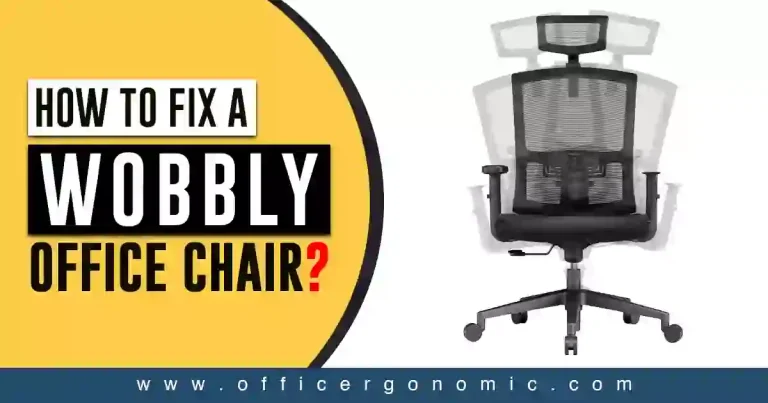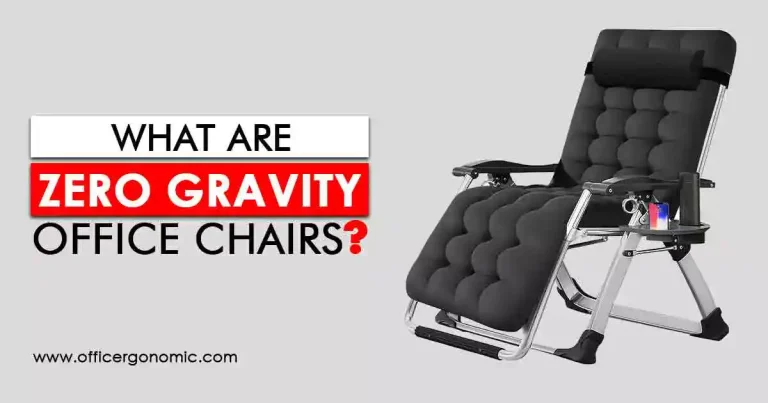Are Kneeling Chairs Good for Sciatica?
A kneeling chair is a particular style of chair that is designed to encourage proper posture and ease lower back strain. It is made to support the body while it is positioned in a kneeling position.
But the real question is “Are kneeling chairs good for sciatica?” We all know that sciatica nerve pain is a painful condition that makes it difficult to sit or stand for long periods. Chiropractors, in this regard, recommend using either a kneeling chair or a standing desk as both options significantly help with sciatica.
There are several benefits of kneeling chairs, however in this article, we will be discussing whether or not kneeling chairs help sciatica patients, how they benefit from them, and all other related things. So keep reading!
What is a Kneeling Chair?
Kneeling chairs have become immensely popular as a way to reduce back pain and improve poor posture. While sitting in a kneeling chair, the knees we resting on a lower pad, and the shins rest on a padded cushion. A kneeling chair’s forward-sloping seat assists in maintaining the spine’s natural curve and helps ease pressure on the lower back thus promoting “active sitting“.
Are Kneeling Chairs Good for Sciatica?
The sciatic nerve is the largest in the body that runs from the lower back to the legs. This nerve is impacted by a condition known as sciatica. Sciatica is signalized by a sharp, shooting pain that radiates from the lower back via the sciatic nerve in the back of the legs.
Other than a herniated disk, it can also be caused by other conditions such as degenerative disc disease, spinal stenosis, or piriformis syndrome. It can have a major impact on someone’s quality of life, limiting their ability to perform everyday tasks and activities.
There are several ways in which kneeling chairs can help relieve the symptoms of sciatica. Some of these include:
1. Evenly Distribute your Weight
Due to the sitting position that you adopt when you use a kneeling chair, your hips will slide forward. With this, your weight will be equally distributed and your shoulders, neck, and spine will be aligned at the same time. This will ensure the removal of your spinal compression and resultantly offer relief from sciatica pain. Also, it stimulates the gluteal muscles and gives a customizable stretch for your hamstring, which can aid in the release of stiffness in this muscle area.
2. Reduces Pressure on the Lower Back
A kneeling chair relieves pressure on the sciatic nerve, which is located in the lower back. When you sit in a regular office chair, your spine is frequently forced into a C-shape, which can put a lot of strain on your lower back.
As a result of this, the pain associated with sciatica may increase. A kneeling chair, on the other hand, promotes a more neutral spine alignment, which assuages pressure on the lower spine and lessens sciatica pain and discomfort.
3. Opens up the Angle between the Trunk and Thighs
When you sit on a typical office chair, your hips and knees form a 90-degree angle, putting a lot of strain on your lower back and pelvis. Sitting in this position for too long can result in pain and discomfort. In such a situation, go for a more ergonomic option, such as a kneeling chair or a saddle-style seat. Kneeling chairs enable the pelvis to forward tilt. This maintains an open angle between the torso and the thighs, which can reduce stress on your lower back and pelvis.
4. Promotes Upright Posture
A good posture is essential for maintaining a healthy spine and preventing and managing back pain. Kneeling chairs are designed to promote an upright posture. This posture helps to maintain the natural curvature of the spine and depletes the strain on the muscles and ligaments of the back.
Moreover, by sitting in an upright position, you are less likely to slouch or hunch over, which can be helpful with sciatica pain.
5. Improves Circulation
Another benefit of kneeling chairs is that they encourage movement. When you sit in traditional office chairs, you are often encouraged to stay in one position for long periods, which can be harmful to your health. In contrast, kneeling chairs allow you to move around more freely, which can help to relax stiffness and improve circulation to the legs and feet. This can be particularly beneficial for minimizing the symptoms of sciatica, relieving pain, and improving mobility.
6. Strengthening Core Muscles
Core muscles are necessary for maintaining good posture and limiting back pain. Using a kneeling chair can help strengthen the core muscles. When you sit in a kneeling chair, your core muscles are engaged as you maintain your balance. As your core muscles are activated throughout the day, they will become stronger over time. Consequently, this will limit the risk of lower back pain and other issues that might aggravate sciatica.
Are Kneeling Chairs Suitable for Everyone with Sciatica?
While kneeling chairs might be beneficial for some persons suffering from sciatica, they are not always the ideal choice for everyone. Here are some things to think about before adopting a kneeling chair:
1. Comfort Level
Kneeling chairs can be tricky to get used to, and some people may find them inconvenient. But with a bit of practice, they can provide a healthy alternative to sitting in traditional chairs. However, it is critical to test out a kneeling chair before purchasing one to assure that it is comfortable and meets your requirements.
2. Flexibility
Those suffering from sciatica may find it difficult to move into and out of a kneeling posture, especially if their flexibility is limited. Many people, however, discover that focusing on hip stretching and strengthening can allow them to comfortably conduct kneeling exercises. It is advisable to assess your level of flexibility when using a kneeling chair.
3. Pre-existing Conditions
Kneeling chairs may be difficult to use for those who have pre-existing illnesses such as knee or hip issues. If you have any pre-existing issues, you must check with a doctor or physical therapist before adopting a kneeling chair. Your doctor can suggest the best possible way to deal with your ailments.
4. Duration of Usage
While kneeling chairs can be advantageous, they should not be used for long periods. Kneeling chairs are designed to maintain the body’s natural curve and mitigate pressure on the spine. However, prolonged kneeling can cause muscle fatigue in the legs and back, resulting in a decrease in productivity.
Do Chiropractors Suggest Sitting on a Kneeling Chair?
It is a common observation that if a patient spends a lot of time sitting, he/she suffers from certain health conditions. These conditions mainly include lower back stress, numbness or tingling in legs, or swollen ankles. In such scenarios, when it comes to picking an appropriate chair for their patients, chiropractors have entirely particular requirements.
More often, chiropractors search for chairs with the capacity of elevation, armrests, seat adjustment with a forward tilt, and lumbar support. All of these elements are intended to aid in the improvement of posture and the prevention of back discomfort.
Furthermore, many chiropractors favor chairs with a waterfall front edge because it relieves strain on the thighs and promotes better circulation of blood.
With the benefits of improved posture, proper balance, and the reduction of muscle fatigue, it is no wonder that kneeling chairs are gaining in popularity. So instead of a traditional chair, chiropractors advise their patients to use kneeling chairs.
However, it is crucial to note that kneeling chairs aren’t for everyone. Many people may find them unpleasant or even bothersome to their conditions.
To evaluate whether a kneeling chair is an appropriate seating option for your particular requirements and circumstances, it is always preferable to contact a chiropractor or other healthcare practitioner.
It is also worth considering that the significance of any seating choice in lowering or managing back pain and other issues varies. It completely depends on the individual, and it’s always best to keep excellent posture and take frequent breaks from sitting, regardless of the kind.
Tips for Choosing the Best Seating for Sciatica
Since prolonged sitting can worsen sciatica, it is vital to choose a seating arrangement that will help you relieve the symptoms and feel better. Here are some suggestions for choosing the best seating for sciatica.
Choose a Chair providing Good Lumbar Support
A chair with good lumbar support will help to maintain the natural curve of your spine, reducing pressure on the lower back and easing sciatica pain.
Look for an ergonomic chair with an adjustable backrest and lumbar support that can be positioned to fit the natural curve of your lower back.
Use a Regular or Medicated Cushion
Sitting on a soft cushion can help to relieve pressure on your sciatic nerve. Look for a cushion that is designed to lessen pressure on the tailbone and lower back. Keep in view that your cushion should be made from a material that will not compress too much over time. The best option is an ergonomic or medicated cushion.
Sit while Placing your Feet Flat on the Floor
To reduce strain on your lower back and sciatic nerve, sitting with your feet flat on the floor can help a lot. If you are having difficulty doing so because of your high chair, use a footrest to support your feet.4
Take Regular Breaks for Extended Sitting
Sitting for long periods can still aggravate sciatica even with the best seating arrangement. To avoid such unpleasant conditions, avoid sitting for prolonged periods. It is important to take breaks to stand up and stretch and opt for a different position or chair after using a kneeling chair for an extended period.
Avoid Slouching and Maintain Posture
Slouching can exacerbate sciatica and put stress on your lower back. Additionally, slouching can reduce the amount of oxygen that reaches your lungs, making it more difficult to breathe. If you are suffering from sciatic pain, then maintain a straight back, relax your shoulders, and distribute your weight on both hips while seated.
Buying a Kneeling Chair for Sciatica Pain!
Once you know how to sit comfortably on a kneeling chair, it’s time to actually buy one. Although the market is flooded with many different types of kneeling chairs in varied price ranges, choosing the right kneeling chair for sciatica pain isn’t easy.
People with no budget limitations can go for any high-quality kneeling chair without having to worry about the price, but those with a limited budget need to do some extra research.
If you’re looking for a good kneeling chair under $200, try out Luxton ergonomic kneeling chair, Sleekform kneeling chair, or DRAGONN ergonomic kneeling chair. All these kneeling chairs not only provide quality but also fit into your budget.
Last Thoughts!
Sciatica pain is a serious thing, which requires regular physical activity along with the use of an ergonomic office chair. The combination of both can help alleviate sciatica symptoms. Ergonomic kneeling chairs are useful tools for alleviating the symptoms of sciatica. They offer several benefits, including promoting good posture, minimizing pressure on the lumbar spine, and improving blood circulation.
However, kneeling chairs are not suitable for everyone, and it is essential to consider factors such as comfort level, flexibility, and pre-existing conditions before using one. If you are experiencing severe or persistent sciatica pain, it’s important to consult with a medical professional or physical therapist for diagnosis and determine the best course of treatment.












